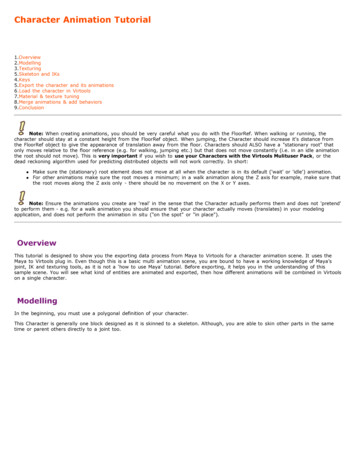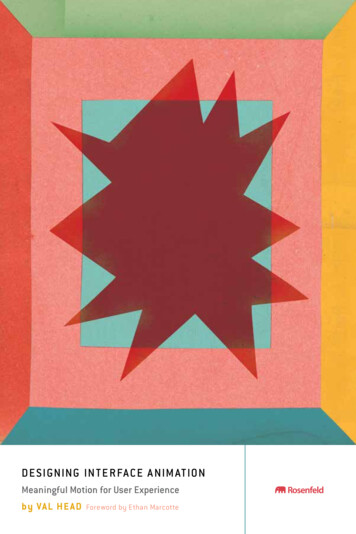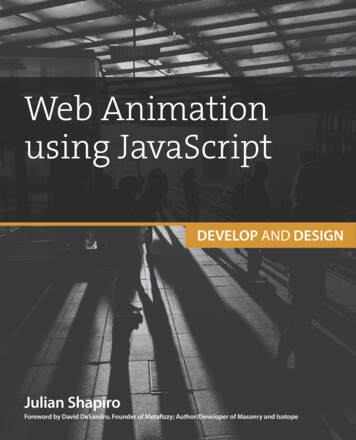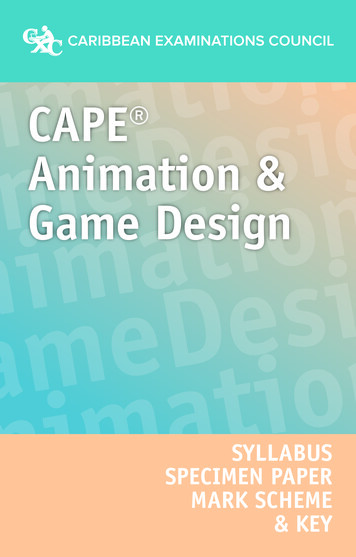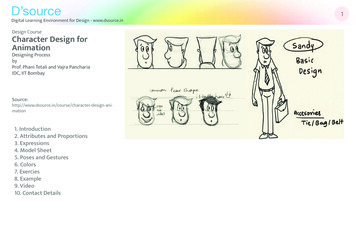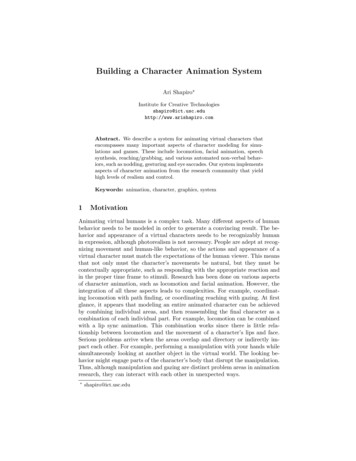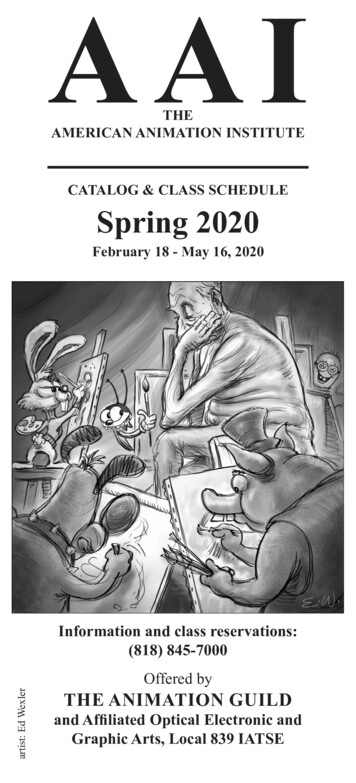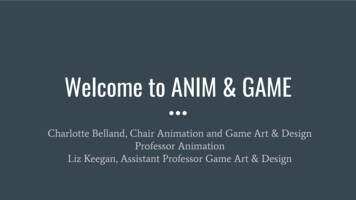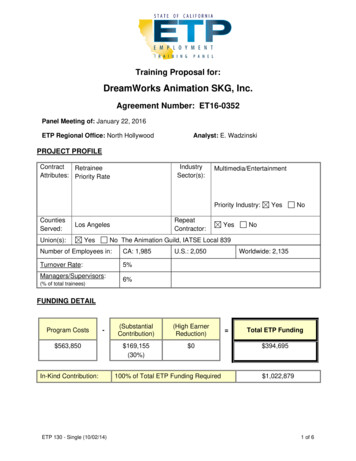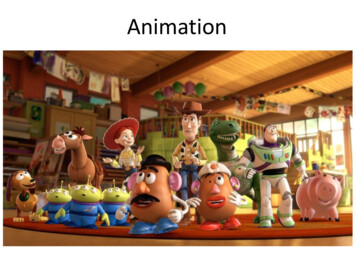
Transcription
Animation
What is Animation? Animation is the rapid display of asequence of images to create an illusionof movement The most common method of presentinganimation is as a motion picture Humans require 16 HZ minimum; 24 Hzused for films; 30Hz used for TV
Animation Each frame is a photograph, drawing,or computer generated image Each frame differs slightly from theone before it Viewing the frames in rapidsuccession implies “motion”
How Animation is Generated Typical examples include: Keyframing (specified by hand)Data-Driven (motion capture)Procedural (rules, flocks)Simulation (laws of physics)
History of Animation Paleolithic (old stone age) cave paintings– animals depicted with multiple legs in superimposedpositions to convey the perception of motion
History of Animation Zoetrope As the cylinder spins, onelooks through the slits at thepictures One sees a rapid succession ofimages, producing the illusionof motion The earliest known zoetropewas created in China around180 CE (may have existed inChina even 300 or so yearsbefore that)
History of Animation Phenakistoscope A spinning disc attached vertically to ahandle A series of drawings around the disc'scenter A series of equally spaced radial slits The user spins the disc and looksthrough the moving slits at the disc'sreflection in a mirror Invented by a Belgian physicist JosephPlateau in 1841
History of Animation Praxinoscope– Improved on the zoetrope byreplacing slits with an inner circle ofmirrors– Invented in France in 1877 by CharlesÉmile Reynaud– In 1889, he invented animproved version thatallowed one to project theimages onto a screen
History of Animation Flip book– The first form ofanimation to employ alinear sequence ofimages, rather than acircular set– In 1868, John BarnesLinnett patented it underthe name kineograph("moving picture“)Click for movie
History of Animation Cinematograph– Fed the linear film through witha hand operated crank– Projected the images onto alarge screen– Invented in 1895 by the Lumierebrothers– Took their “film projector”around the world, chargedadmission for movies– Original films were 17 meterslong and lasted 50 seconds
Hollywood First film studioestablished in Hollywoodin 1911, followed by 15more later that year Charlie Chaplin Studiosestablished in 1917 Silent Film Era until 1929 1st Academy Awards in1929
Golden Age of Hollywood 1927-1963
Stop Motion Physically manipulate real-world objects and photograph them oneframe at a time to create the illusion of movement Create and tell non-physical non-real-world storiesClick for movie
Stop Motion Gumbasia was the first clay animationA short film produced in 1953 and released onSeptember 2, 1955Produced by Art Clokey, who went on tocreate the classic series “Gumby” and “Daveyand Goliath” using the same techniqueClick for movie
Cartoons Produced in large numbersin the Golden Age ofHollywood; usually shownbefore feature films First animated full lengthfilm: Snow White, 1937(took 4 years to make) Moved to TV in the 1950’s,when TV became popular– Flintstones: first successfulprime time TV cartoon
Cel Animation The drawings are drawnin layers, and stackedbefore photographingthem Saves time, since thebackground and staticobjects only need to bedrawn once Can archive and reuse canned animation cycles(sequences of cels) for running, jumping, etc.
Key Frames Need to stay cost efficient Advanced artists model a set of key poses or key frames for thecharacters Beginner artists filled in the motion in between these keyposes
Cartoon Computer Animation Traditional Animation was replaced with 2D Computer Animationcirca 1990 while still using the concepts of static backgrounds, keyframing, animation cycles, etc.
Question #1 LONG FORM: Give a brief history of animation. SHORT FORM: What is your favorite movie? Was there an important character, environment, or scene in thatmovie that required special effects (i.e. something that one could notgo out and film with a video camera)?
Arcade Games Space Invaders 1978; Pac Man 1980; Donkey Kong 1981 Golden Age of Arcade Games 1978-1985
Game Consoles there were no 1st gen consoles – just dedicated hardware e.g. Pong 1975 Atari 1977 (2nd gen); Nintendo 1985 (3rd gen); SNES 1991 (4th gen); Playstation 1995(5th gen)
3D Video Games Nintendo 64 (5th gen) & Super Mario 64, both 1996, widely popularized 3Dvideo games Playstation 2 2000; Nintendo Gamecube 2001; Xbox 2001 (all 6th gen) Playstation 3 2006; Nintendo Wii 2006; Xbox 360 2005 (all 7th gen) Playstation 4 2013; Wii U 2012; Xbox One 2013 (all 8th gen)
Nintendo Switch
Question #2 LONG FORM: Give a brief history of video games. SHORT FORM: What is the first video game you can recall ever playing? About howold were you? What is the last video game you can recall playing? When was that? What is your favorite video game? Why?
3D Computer Animated Films Toy Story 1995, Pixar Animation Studios
3D Computer Animated Films 3D figures are rigged with a virtual skeleton The limbs, eyes, mouth, clothes, etc. are moved by the animatoron key frames Positions in between key frames are filled:– Brute Force Manually set values for every frame Extremely expensive– Traditional Keyframing In-between frames are specified by beginners Still extremely expensive– Computer Keyframing In-between frames are computer generated Relatively cheap Finally, the animation is rendered
Principles of Animation John Lasseter– Animator, film director, chief creativeofficer at Pixar and Walt DisneyAnimation Studios, Principal CreativeAdvisor for Walt Disney Imagineering– Oversaw all of Pixar's films and associatedprojects as executive producer– Directed Toy Story, A Bug's Life, Toy Story2, Cars, and Cars 2– "Principles of Traditional AnimationApplied to 3D Computer Animation",Computer Graphics, pp. 35-44, 21:4, July1987 (SIGGRAPH 87).
Various principles in actionClick for movieFlour Sack animationRon Zorman, animator at Pixar, known for Finding Nemo, The Incredibles, WALL-E, Up, etc.
Principles of Animation Squash and StretchTimingSlow in Slow outAnticipationFollow Through and Overlapping ActionStagingExaggerationSolid Drawing and Appeal
Squash and Stretch Defining the rigidity and massof an object by distorting itsshape during an action The volume should remainconstant"Principles of Traditional Animation Applied to 3D Computer Animation",SIGGRAPH 87 Very important in facialanimation"Illusion Of Life" by Frank Thomas & Ollie Johnston, Hyperion Press, (ISBN 0786860707), 1981"Principles of Traditional Animation Applied to 3D Computer Animation", SIGGRAPH 87
Timing Spacing actions to define the weight and sizeof objects and the personality of characters.Timing for animation, Harold Whitaker, John Halas, Focal Press, 2002
Slow In Slow Out The spacing of the “in-between” drawings betweenthe extreme poses Mathematically, it refers to the second and third order continuity of motion Grouping the in-betweens closer to an extreme to be more expressive orrealistic"Principles of Traditional Animation Applied to 3D Computer Animation", SIGGRAPH 87.
Anticipation An action has threeparts The preparation for theaction - this is anticipation The action The termination of the action Prepare the audience for the nextmovement and direct theirattention to a certain part of thescreen"Illusion Of Life" by Frank Thomas & Ollie Johnston, Hyperion Press, (ISBN0786860707), 1981
Follow Through and Overlapping Action Follow through is the termination of an action Actions are generally carried past their termination point Overlapping means to start a second action before the first action hascompletely finished This keeps the interest of the viewer, since there is no dead time betweenactions"Illusion Of Life" by Frank Thomas & Ollie Johnston, Hyperion Press, (ISBN 0786860707), 1981.
Staging The presentation of an idea so that it is clear Lead the viewers eye to where the action will occur Only one idea should occur at a timeCartoon Animation, Preston Blair, Walter Foster, 1984
Exaggeration Exaggerate to make the actionmore believable andexpressive Also done by stage actors (Along with many of the otherprinciples )Cartoon Animation, Preston Blair, Walter Foster, 1984
Solid Drawing and Appeal Solid drawing stresses the importance of three-dimensional shapes, accurateanatomy, and animation work that has a sense of weight, balance, light, andshadow Appeal is a quality of charm, pleasing design, simplicity, communication, ormagnetism E.g. in creating an appealing character pose, avoid “twins” where both arms or legs arein the same position doing the same thing"Illusion Of Life" by Frank Thomas & Ollie Johnston, Hyperion Press, (ISBN 0786860707), 1981.
CG Humans are Hard As characters get more and more real, quality becomesextremely important But even state of the art animation, geometry,rendering, simulation, etc. can lead to disturbingzombie-like characters It’s difficult to remove enough errors to make humansseem real
CG Humanoids are Easier On the other hand, it seems quite easy to slap together acompletely unrealistic robot, and make it endearing We respond quite positively to human like characters as longas they’re not too human And we’re quite forgiving of any lack of realism
Uncanny Valley
Uncanny Valley Stay on the left side of the valley Don’t shoot for real, shoot for “stylized”– Much easier than real Alterations to make less human– “Futuristic” humans– Military suits– Super powers
Question #3 LONG FORM: Briefly describe each of the principles of animation. What is the uncanny valley? SHORT FORM: What is your favorite non-human character in a book, TV-show,feature film, or game? How do they relate to the uncanny valley?
Animating via Simulation Describe motion using the laws of physics, biomechanics, andvarious other equations and rules Then automatically generate animation by solving the relevantequations If the equations are valid/adequate and can be solved robustlywith minimal errors, then one can automatically generate realisticanimations Minimizing human time in the specification of key frames, whileincreasing the need for computational resources In fact, simulation can take an excessive amount of computer and wallclock time One still needs to set initial and boundary conditions, variousmaterial parameters, geometric constraints, design algorithmsand controls, etc. It’s definitely not a panacea, but has been invaluable for manyaspects of computer animation Smoke, fire, water, explosions, destruction, clothing, flesh, hair, etc
Animation vs. able, expressive, stylized motionhard to make look realistic,tedious to specify every detailautomatic generation, no need (or lessneed) for by hand manipulationfollows physics laws and equations,often easier to make look realistic
What can we simulate? One can draw a line between animation and simulation atvarious levels Take character animation as an example:AnimationSimulationMotion of the bodyPassive motion of clothMotion of bonesPassive deformation of fleshSignals in the nerve systemResponses of the muscles and passivemotion of bonesBrain activitySignals transferred in the nerve system
Arcade Games there were no 1. st. gen consoles –just dedicated hardware e.g. Pong 1975 Atari 1977 (2. nd. gen); Nintendo 1985 (3 . rd. gen); SNES 1991 (4. th. gen); Playstation 1995 (5. th. gen) Game Consoles Nintendo 64 (5. th. gen) & Super Mario 64, both 1996, widely popularized 3D video games Playstation 2 2000; Nintendo Gamecube 2001; Xbox 2001 (all 6. th. gen .
